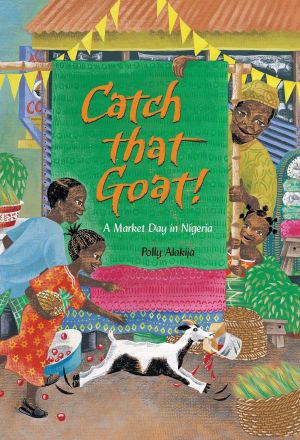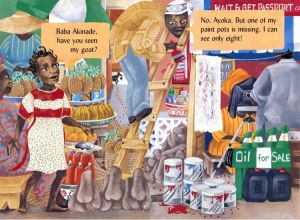Catch That Goat! by Polly Alakija
Catch That Goat! was written by by Polly Alakija. New Ed edition was published this book in March 1, 2007. Th book has 40 paes long and suitable for the readers from 2-6 years old. The item Weight ia 6.4 ounces and the dimensions is 8.5 x 0.12 x 10.71 inches.[1]
Polly Alakija born in 1966 and she is a British muralist, artist and children's book author. Born in Britain, she moved to Nigeria upon marrying her Nigerian husband and most of her works focus on Nigerian-themed concepts. She was an artist in residence for the 2015 Cheltenham Jazz Festival and had a solo exhibition at the Quintessence Gallery, Ikoyi also in 2015. A number of her works are composed of paintings of objects such as Cycle rickshaws called marwa in Nigeria, molue bus and Volkswagen Beetles.[2]
Summary
Learn more about Nigeria and the Yoruba language with this new extended edition! Now includes seven additional pages of maps and cultural information. Ayoka has been left in charge of the family goat, but within minutes it has vanished! As Ayoka searches the streets of town, she sees how much trouble a runaway goat can cause among the market stalls. One thing after another disappears, and when Ayoka finally catches up with the goat, she finds more than she had bargained for. A proper book to teach the children counting and being responsible.[3]
Pros
A compilation of positive comments about this book, could be seen in one of online sites. This book has some wonderfully done illustrations in bright, vivid watercolors and tons of detail. The book has all kinds of texture features in the paint that make each page very interesting. It was a great book that looks at the culture and language of Nigeria and brings the place to life. This book could be used to help teach counting and also features some African cultures. It was introducing the concept of subtraction and it's fun to see a mischievous goat theme as well.[4]
One fully detail article about this book was made by Toyin Falola, the illustrations more impressive than the story. The colors are many, bold, and bright, and they capture the energy and vibrancy of a Nigerian street market. Children interested in drawing and painting have a lot to practice with and copy. The goat and Ayoka look really nice, and Mama Ayoka is both attractive and well dressed. Introduced to a Western audience in very creative ways are various objects from Africa, the goat, hen, pots, fruits, vegetables, pepper, yam, cage, mortar, pestle, pots, broom, fabric, market scene, market stalls, and babies carried on the back by their mothers. Children will see a different concept of a market and grocery store, as yams are sold together with oil in the same location, while a photographer and a painter carried on their duties by the side of women traders. and so on in the context of a Nigerian society, the names and characters are drawn from the Yoruba. Ayoka, Kudi, and other names "blend" very well with the setting and the story line. The approach also takes from the Yoruba how to teach children good manners, interpersonal relationships, and arithmetic at the same time, all through the medium of simple stories. There is also a morality dimension, children should take the responsibility very seriously, and they are accountable for their actions. Young kids can use the story to learn how to count backward, from ten to one, without the need to learn by rote.[5]
References
- ↑ Catch That Goat!: A Counting Tale from Nigeria. amazon.com. Retrieved January 25th, 2021
- ↑ Polly Alakija. Retrieved January 25th, 2021
- ↑ Catch That Goat! - by Polly Alakija (Paperback). Retrieved January 25th, 2021.
- ↑ Catch That Goat!. goodreads.com. Retrieved January 25th, 2021.
- ↑ Falola on Alakija, 'Catch That Goat!'. Retrieved January 25th, 2021

